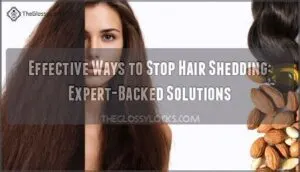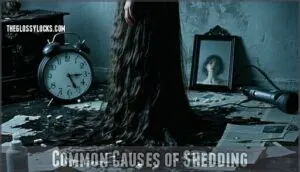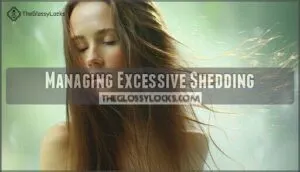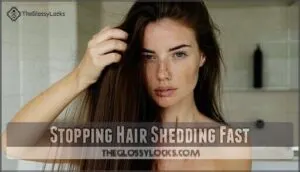This site is supported by our readers. We may earn a commission, at no cost to you, if you purchase through links.
 You can tackle hair shedding like a detective solving a case—start by identifying the culprit. Stress, poor nutrition, and harsh styling often play the villain in your hair’s story.
You can tackle hair shedding like a detective solving a case—start by identifying the culprit. Stress, poor nutrition, and harsh styling often play the villain in your hair’s story.
The most effective ways to stop hair shedding include eating protein-rich foods, managing stress through exercise or meditation, and treating your strands gently.
Skip the scorching hot showers and aggressive towel-drying that make your hair cry for mercy. Instead, use lukewarm water, sulfate-free shampoos, and wide-tooth combs.
Scalp massages with essential oils boost circulation, while supplements like biotin and iron address nutritional gaps. The secret lies in understanding what specific triggers affect your unique situation.
Table Of Contents
- Key Takeaways
- Hair Shedding Basics
- Common Causes of Shedding
- Identifying Hair Shedding
- Preventing Hair Shedding
- Managing Excessive Shedding
- Stopping Hair Shedding Fast
- Maintaining Healthy Hair
- Frequently Asked Questions (FAQs)
- How do I stop my hair from shedding so much?
- How can I stop my hair from dropping?
- What vitamin am I lacking if my hair is shedding?
- Why is my hair system shedding so much?
- Can hair shedding be completely reversed permanently?
- How long before shedding improvements become visible?
- Do hair masks actually prevent shedding effectively?
- Should I wash hair less to reduce shedding?
- Are expensive hair treatments worth the investment?
- Conclusion
Key Takeaways
- Address the root causes first – You’ll need to identify what’s triggering your excessive shedding, whether it’s stress, poor nutrition, hormonal changes, or heat damage, since treating symptoms won’t give you lasting results.
- Feed your hair from the inside out – You can’t expect strong hair without proper nutrition, so focus on protein-rich foods, iron, B vitamins, and biotin while staying hydrated to strengthen your follicles naturally.
- Handle your hair like it’s fragile silk – You should use wide-tooth combs, lukewarm water, sulfate-free shampoos, and avoid aggressive towel-drying or tight hairstyles that snap strands at the root.
- Be patient and consistent with your routine – You won’t see improvements overnight, but with 2-3 months of consistent care addressing nutrition, stress management, and gentle handling, you’ll notice significant changes in your hair’s strength and shedding patterns.
Hair Shedding Basics
You’ll lose about 50 to 100 hairs daily as part of your scalp’s natural renewal process, where old strands make room for new growth through a carefully orchestrated cycle.
Understanding this normal shedding pattern, along with recognizing when hair loss becomes excessive, helps you distinguish between healthy turnover and potential problems that need attention.
Normal Hair Shedding Levels
Understanding your normal hair loss baseline is essential before worrying about excessive shedding.
You’ll typically lose 50-150 strands daily, with individual differences based on hair type and seasonal variations.
During the hair growth cycle, 85% of follicles remain in anagen (growth phase) while 8-9% rest in telogen (shedding phase), making daily strand count naturally fluctuate.
It’s worth noting that normal daily hair loss typically falls between 50 and 100 strands.
Signs of Excessive Hair Shedding
Spotting excessive hair shedding isn’t rocket science when you know what to look for. Your body sends clear signals when normal hair loss crosses into concerning territory.
Watch for these telltale signs:
- Pillow Hair Count – Finding clumps on your pillowcase daily
- Shower Drain Check – Noticing substantially more strands after washing
- Part Line Width – Your part appears wider than usual
- Ponytail Thickness – Your ponytail feels noticeably thinner
Hair Growth Cycle Phases
Your hair growth cycle typically runs like clockwork through four distinct phases.
During anagen, your hair actively grows for 3-5 years, while catagen marks a brief interim period.
Telogen represents the resting phase before exogen triggers shedding.
Follicle asynchronicity prevents simultaneous hair loss, but cycle disruption from stress can cause telogen effluvium, dramatically increasing daily shedding beyond normal levels.
Nutrition plays a pivotal role, impacting the anagen phase duration.
Common Causes of Shedding
While losing 50-100 hairs daily is completely normal, excessive shedding often stems from specific triggers that you can identify and address.
Understanding these common culprits, from stress and hormonal fluctuations to poor nutrition and heat damage, empowers you to take targeted action and restore your hair’s natural balance.
Stress and Hormonal Changes
Your body’s stress response can wreak havoc on your hair follicles.
Your hair follicles are basically stress detectors – when you’re overwhelmed, they go on strike and start shedding like crazy.
When cortisol levels spike from chronic stress, your hair enters a resting phase prematurely, leading to stress related hair loss.
Hormonal changes during postpartum shedding, menopause effects, and thyroid impact also disrupt normal growth cycles.
Managing hormonal imbalance through stress management techniques helps restore healthy hair patterns naturally.
Many women are unaware that their symptoms are hormone related.
Poor Nutrition and Diet
Your fork can be your best friend or worst enemy in the matter of hair shedding.
Dietary deficiencies create a perfect storm for hair loss causes, while proper nutrition acts as your scalp’s insurance policy.
Three nutrition mistakes that’ll make your hair bail:
- Skipping protein intake – your hair needs 40-60 grams daily
- Ignoring vitamin importance – B12, D, and iron deficiencies spell trouble
- Forgetting hydration effects – dehydrated follicles equal breakage
Heat and Chemical Damage
While nutrition plays a foundational role, external factors wreak havoc on your hair’s health.
Heat styling tools like blow dryers and flat irons literally cook your hair strands, while chemical treatments strip away protective layers. Product buildup clogs follicles, creating a breeding ground for breakage.
Understanding these damage sources helps you make smarter styling choices.
| Damage Type | Common Causes |
|---|---|
| Heat damage | Blow dryers, curling irons, flat irons over 300°F |
| Chemical damage | Hair dyes, perms, relaxers, bleaching treatments |
| Product buildup | Heavy styling creams, dry shampoos, hairsprays |
| Mechanical breakage | Tight brushing, rubber bands, aggressive toweling |
| Environmental stress | UV exposure, chlorine, salt water, pollution |
Your hair can’t repair itself once damaged – prevention beats damage repair every time.
Scalp Problems and Seasonal Shedding
Beyond styling damage, scalp conditions create another layer of shedding challenges.
Dandruff impact and scalp inflammation disrupt your follicle health, while seasonal triggers like pollen cause additional stress.
Oily scalp leads to follicle clogging, preventing proper growth.
During allergy season, dust particles settle on your scalp, creating irritation.
A consistent scalp care routine with gentle scalp treatments and regular scalp exfoliation maintains healthy scalp health.
Identifying Hair Shedding
You’ll need to track your daily hair loss and recognize warning signs to determine whether your shedding falls within the normal range of 50-100 strands per day.
By monitoring patterns like increased hair on your pillow, in the shower drain, or when you run your fingers through your hair, you can identify excessive shedding that requires attention and treatment.
Monitoring Daily Hair Loss
Tracking your hair shedding patterns helps distinguish normal loss from concerning levels.
Most people lose 50-100 strands daily, but monitoring creates awareness of your baseline.
Here are effective shedding count methods:
- Pillow Test – Count strands on your pillowcase each morning for one week
- Shower Drain Method – Collect and count hairs after washing for pattern identification
- Gentle Tug Assessment – Run fingers through dry hair sections, noting abnormal loss thresholds
- Digital Tracking Tools – Use smartphone apps to log daily counts and identify trends
- Photo Documentation – Take weekly scalp photos for early intervention and visual comparison
Recognizing Signs of Excessive Shedding
Now that you’re tracking your daily hair loss, watch for these red flags that signal excessive hair shedding.
Check your pillow hair count each morning—finding clumps means trouble.
Notice your shower drain check revealing substantially more strands than usual.
Your ponytail thickness shrinking over weeks indicates hair thinning.
A widening part line width or receding hairline confirms you need professional hair loss diagnosis.
Checking for Underlying Health Issues
Your doctor’s expertise becomes invaluable when excessive hair shedding persists beyond three months.
Blood tests can reveal thyroid dysfunction, iron deficiency hair loss, or vitamin deficiency affecting your follicles. Deficiencies in key nutrients can also play a significant role, as iron impacts hemoglobin.
Hormonal imbalances from PCOS or autoimmune diseases often trigger shedding, while medication side-effects frequently go unnoticed. Don’t dismiss persistent hormonal changes—early detection prevents permanent damage.
Preventing Hair Shedding
You can substantially reduce hair shedding by making simple changes to your daily routine, including eating nutrient-rich foods and managing stress levels effectively.
The key lies in understanding that prevention requires a balanced approach combining proper nutrition, gentle hair care practices, and protecting your strands from damage.
Balanced Diet and Nutrition
A healthy hair diet is your first line of defense against hair shedding.
Focus on these essentials:
- Vitamins and Minerals: Load up on B vitamins, iron, and zinc to combat nutrient deficiencies.
- Protein Intake: Hair thrives on protein, so include lean meats, eggs, or beans.
- Hydration and Healthy Fats: Drink water and eat avocados or nuts to keep strands shiny and strong.
Reducing Stress and Heat Damage
When life throws curveballs, your hair often pays the price.
Stress triggers telogen effluvium, forcing follicles into premature shedding phases. Heat styling compounds this damage, creating a double threat to your strands.
You’ll need strategic stress reduction and heat protection to break this cycle and preserve your hair’s natural strength.
| Stress Management | Heat Protection |
|---|---|
| Practice meditation daily | Use heat protectant sprays |
| Exercise regularly | Limit styling to 2-3 times weekly |
| Get 7-8 hours sleep | Keep tools under 350°F |
| Try yoga or breathing exercises | Air-dry when possible |
| Consider stress counseling | Invest in ceramic/tourmaline tools |
Gentle Hair Care and Handling
Handle your hair like delicate silk to prevent unnecessary shedding.
Use wide-toothed combs for gentle brushing, starting from ends and working upward.
Pat hair dry with soft towels instead of aggressive rubbing.
Sleep on silk scarves or pillowcases to reduce friction.
Limit heat styling to further protect hair.
Choose protective styles that don’t pull or strain follicles, minimizing hair breakage and supporting your hair’s natural strength.
Managing Excessive Shedding
When you’re losing more than 100-150 hairs daily, it’s time to take targeted action to restore your hair’s natural balance.
You’ll need a strategic approach that combines proper nutrition, gentle care techniques, and protective measures to reduce shedding and strengthen your existing hair strands.
Supplements and Vitamins for Hair Health
Strategic supplementation can address vitamin deficiencies that contribute to excessive shedding. Your body needs specific nutrients to maintain strong follicles and prevent breakage.
Your hair is literally what you eat – feed it right, and it’ll reward you with strength and shine.
Key hair shedding vitamins include:
- Biotin for hair – supports keratin production and strengthens strands
- Iron intake – carries oxygen to follicles for healthy growth
- Vitamin B complex – creates red blood cells that nourish roots
- Omega-3s – reduce inflammation and improve supplement absorption
Hair supplements work best when combined with proper nutrition. Consider researching biotin supplement options to find a suitable product.
Deep Conditioning and Moisturizing
Dry hair breaks easier, making deep conditioning your secret weapon against hair shedding solutions.
Choose products with ceramides and proteins based on your hair porosity—low porosity needs lightweight formulas, while high porosity craves heavy creams.
Apply from mid-length to ends, focusing on moisture retention through proper application techniques.
Many people find success with quality hair products, which provides a hair hydration boost that strengthens strands and reduces hair shedding treatment needs substantially.
Protecting Hair From Breakage and Damage
Beyond deep conditioning, protecting your hair from breakage requires a multi-faceted approach. Your hair’s strength and elasticity depend on how you handle it daily.
Hair breakage prevention starts with understanding what damages your strands most. Here’s what threatens your hair’s integrity:
- Heat styling tools that literally cook your hair proteins
- Tight ponytails that snap strands at the root
- Harsh chemicals that strip away protective barriers
- Rough towel-drying that creates microscopic tears
Gentle brushing prevents unnecessary hair damage while maintaining hair strength through proper care techniques, which is crucial for preventing hair breakage and requires a daily effort to handle your hair with proper care.
Stopping Hair Shedding Fast
When you’re losing more hair than usual, you’ll want immediate solutions that target the root causes rather than just temporary fixes.
The most effective approach combines identifying triggers like stress, nutrient deficiencies, or heat damage with strategic changes to your diet, hair care routine, and product choices, which ultimately leads to a more effective approach.
Identifying and Addressing Underlying Causes
First, you’ll need to play detective with your hair loss.
Medical conditions like thyroid disorders, hormone imbalance, and nutrient deficiencies often trigger excessive shedding.
Check if medications you’re taking list hair loss as side effects.
Scalp conditions, chronic stress, and lifestyle factors frequently cause hair shedding and hormonal imbalances that disrupt your natural growth cycle.
Improving Diet and Reducing Heat Damage
Within weeks, you’ll see results by making key dietary changes and reducing heat styling damage.
Focus on protein-rich foods, iron, and vitamins B and D to strengthen follicles.
Switch to air-drying or heat protection sprays when styling, and consider supplement choices like biotin and zinc.
Remember, hydration importance can’t be overstated—drink plenty of water daily for superior hair health.
Choosing Suitable Hair Products and Treatments
Finding the right hair care products feels like searching for a needle in a haystack, but understanding your hair’s unique needs makes all the difference.
Match products to your specific hair type and scalp sensitivity to stop hair shedding effectively. Many people are now opting for gentle hair cleansers to avoid irritation.
- Product Ingredients: Look for sulfate-free shampoos and nourishing conditioners with biotin, keratin, or natural oils
- Treatment Types: Choose between professional hair loss treatments like minoxidil or gentler DIY remedies with essential oils
- Scalp Sensitivity: Select fragrance-free, hypoallergenic formulas if you experience irritation or have sensitive skin
- Professional Advice: Consult a trichologist for personalized hair shedding remedies when over-the-counter solutions aren’t working
Maintaining Healthy Hair
Maintaining Healthy Hair – Introduction
Once you’ve addressed the immediate causes of excessive shedding, maintaining healthy hair becomes your long-term strategy for preventing future problems.
You’ll need to establish consistent routines that support your hair’s natural growth cycle while protecting it from daily damage that accumulates over time, which is crucial for preventing future problems and ensuring your hair’s natural growth cycle.
Regular Health Check-Ups and Hair Care
Regular health check-ups enable early detection of underlying hair shedding causes like thyroid issues or nutritional deficiencies.
Professional consultation provides personalized treatments customized to your specific needs.
A holistic approach combining medical evaluation with a consistent hair care routine addresses both internal and external factors.
Preventative measures through routine monitoring help identify problems before they worsen, making hair shedding remedies more effective.
Avoiding Harsh Treatments and Styles
Your hair care routine after regular check-ups should prioritize gentle hair styling over aggressive treatments. Chemical avoidance and heat alternatives protect your strands from unnecessary damage.
Tight hairstyles create tension that accelerates hair shedding, while protective hairstyles maintain scalp health. Smart hair brushing techniques and mindful hair styling practices preserve your hair’s natural strength.
For those with curly hair, consider heatless styling methods to minimize damage.
- Stop yanking your brush through wet hair – it’s like trying to untangle Christmas lights with a sledgehammer
- Ditch the daily flat iron habit – your hair doesn’t need to be poker-straight to look amazing
- Say goodbye to chemical relaxers – they’re basically hair bullies that weaken your strands
- Avoid super-tight ponytails – your hairline will thank you for the breathing room
- Choose silk pillowcases over cotton – it’s like giving your hair a luxurious spa treatment every night
Promoting Hair Growth and Reducing Shedding
Beyond avoiding damaging treatments, you can actively stimulate hair growth through targeted strategies.
Scalp massage increases blood circulation, while proper hydration and sleep quality support follicle health.
DHT blockers and growth serums offer advanced solutions for persistent shedding.
| Method | Frequency | Expected Results |
|---|---|---|
| Scalp Massage | Daily, 5-10 minutes | Improved circulation within 2-4 weeks |
| Growth Serums | Twice daily application | Visible results in 8-12 weeks |
| DHT Blockers | As directed by professional | Reduced shedding in 3-6 months |
Frequently Asked Questions (FAQs)
How do I stop my hair from shedding so much?
Like leaves falling from a tree, your hair’s shedding can slow down.
You’ll need to eat protein-rich foods, manage stress levels, avoid tight hairstyles, and consider gentle scalp massages to strengthen follicles naturally.
How can I stop my hair from dropping?
Start with a balanced diet rich in protein, iron, and vitamins.
Manage stress through exercise or meditation.
Avoid tight hairstyles and harsh chemicals.
Stay hydrated and get adequate sleep for exceptional hair health.
What vitamin am I lacking if my hair is shedding?
You’re likely deficient in iron, vitamin D, zinc, or B vitamins if you’re experiencing hair shedding. These nutrients support healthy follicles and growth cycles, so consider getting blood work done.
Why is my hair system shedding so much?
Ever wonder if your hair system‘s acting up?
Your hair system might be shedding excessively due to poor attachment methods, low-quality materials, heat damage, or normal wear-and-tear from daily styling and environmental factors.
This could be causing your hair system to malfunction, leading to excessive shedding.
Can hair shedding be completely reversed permanently?
Hair shedding can’t be completely reversed permanently since it’s part of your natural hair cycle.
However, you can substantially reduce excessive shedding by addressing underlying causes like stress, nutrition deficiencies, and hormonal imbalances.
How long before shedding improvements become visible?
Like watching grass grow after planting seeds, your hair’s recovery timeline requires patience.
You’ll typically notice initial improvements within 2-3 months, with significant changes visible after 4-6 months of consistent treatment.
Do hair masks actually prevent shedding effectively?
Deep conditioning masks strengthen hair strands and reduce breakage, but they won’t stop shedding caused by stress, hormones, or nutrition.
You’ll see modest improvements in hair texture, though addressing root causes remains essential.
Should I wash hair less to reduce shedding?
Daily washing can strip your scalp’s natural oils, but washing less won’t reduce normal shedding since you’ll simply lose accumulated hairs during your next wash, making it appear worse.
Are expensive hair treatments worth the investment?
Expensive treatments aren’t always necessary for healthy hair.
Professional salon treatments can provide benefits, but many affordable options like proper nutrition, gentle handling, and drugstore products work just as effectively for reducing shedding, utilizing gentle handling.
Conclusion
Studies show that 95% of hair shedding cases can be reduced through proper nutrition and gentle care practices.
You’ve learned the most effective ways to stop hair shedding by addressing root causes rather than symptoms.
Remember that consistency matters more than perfection—implementing even two or three strategies can make a significant difference.
Your hair responds to patience and persistence, so don’t expect overnight miracles.
Start with dietary improvements and stress management, then gradually incorporate specialized treatments for lasting results.














